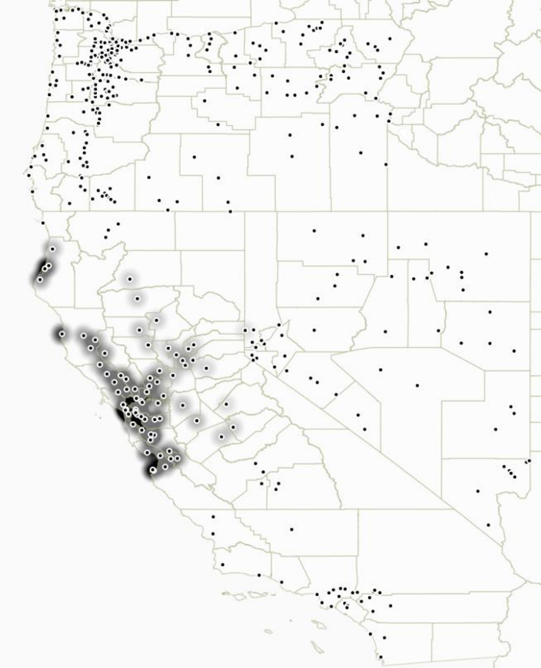In 2017, the 10 largest US metropolitan areas accounted for roughly one-third of America's GDP. As economic activity is clustered within a few core metropolitan areas, a central question in economics is what determines the location of economic activity. One answer as to why such clusters exist is economies of scale (e.g. Krugman 1991), implying high degrees of persistence in the distribution of city sizes. Cities that were relatively large historically are predicted to be relatively large today if they were able to take advantage of scale economies. These theories also predict that large enough population shocks would leave a permanent mark on the spatial distribution of city sizes. Thus, location theories based on scale economies can explain persistence in the placement of the population in the absence of shocks and, at the same time, explain why sufficiently large shocks may imply less persistence over long periods.
In a recent paper (Ager et al. 2019), we exploit newly collected data on population sizes of 412 cities and towns located in the American West, for every decade from 1890-1970, to show that the 1906 San Francisco Earthquake left a permanent mark on relative city sizes. This finding supports the notion that ‘economies of scale’ have been a prominent force in shaping the distribution of economic activity in the region. We provide evidence suggesting that this long-lasting effect is largely a result of individuals' high geographical mobility at that time: less earthquake-affected areas became more attractive migration destinations in the immediate aftermath of the earthquake.
The 1906 San Francisco Earthquake is one of the most significant earthquakes at all time. 18 On April 1906, the earthquake struck at 5:12 am local time without warning (Zoback, 2006). The total length of the rupture was 477 km, and the main epicentre was located about 3 km off the shore of San Francisco. The death toll, economic cost, and the associated fires classify it as one of the worst natural disasters on American soil (Hansen and Condon 1989). The earthquake is naturally associated with the city of San Francisco since it was almost entirely destroyed and the worst affected area. However, as also pointed out by Ellsworth (1990), the intensity of the earthquake was comparable to that felt in the city of San Francisco in many other places close to the San Andreas Fault line, implying that the damage caused by the earthquake was widespread in the American West. The magnitude of the disaster was large enough to possibly alter the relative magnitudes of agglomeration forces from scale economies across cities.
Figure 1 displays the location and the potential intensity of the earthquake for each city and town in our sample, where darker shaded areas indicate a higher damage intensity according to Boatwright and Bundock’s (2005) ShakeMap. Our empirical analysis compares the evolution of relative city sizes between more and less affected cities before and after the earthquake occurred.
Figure 1 Earthquake intensity and sampled cities
Notes: This map shows the cities in the American West included in our sample. Darker shaded areas indicate a higher earthquake intensity. The calculated earthquake intensities are based on Bundock's (2005) ShakeMap.
The results shown in Figure 2 reveal that cities with different earthquake intensities experienced similar population growth from 1890 to 1900, supporting the so-called parallel trend assumption, while after the disaster had taken place, more affected cities experienced less population growth, relative to less or non-affected cities. These empirical patterns indicate that the effect of the earthquake, in terms of relative city sizes, is still measurable in the second half of the 20th century. For example, a one standard deviation higher earthquake intensity is associated with a reduction in population size of 30% in 1970, corresponding to a decrease in the annual population growth rate of 0.7 percentage points. We take several steps to ensure that these findings are not influenced by measurement error in the calculated intensities and other factors changing over the course of the 20th century in the American West. Our finding speaks against the idea that locational fundamentals are the driving force behind the spatial distribution of economic activity that one observes in the American West today.
Figure 2 The effect of the 1906 earthquake on city population size
Notes: This figure shows the dynamic effects of earthquake intensity on city population. The solid line depicts the effect on city population relative to the omitted base year (1900) and the dashed lines depict the corresponding 95% confidence band.
Why did the 1906 San Francisco earthquake have a long-lasting impact on relative city sizes in the American West? One possible explanation is that geographical mobility in the US at that time was relatively high and the earthquake diverted migrants to less affected areas of the American West. We provide evidence, based on newly digitised complete-count US Census samples for the decades surrounding the earthquake (1900-1910), that more earthquake-affected areas experienced a reduced inflow from internal migrants (based on a linked sample of adult males) and foreign-born relative to less earthquake-affected areas. Our analysis suggests that large historical shocks are more likely to have a persistent effect on the location of economic activity when geographical mobility is high, as it was the case in the US during the early 20th century. The high geographical mobility of the affected population played therefore an important role in determining to what extent history mattered for the spatial distribution of economic activity in the American West.
References
Ager, P, K Eriksson, C W Hansen, and L Lønstrup (2019), “How the 1906 San Francisco Earthquake Shaped Economic Activity in the American West”, CEPR Discussion Paper 13632.
Boatwright, J and H Bundock (2005), “Modified Mercalli intensity maps for the 1906 San Francisco earthquake plotted in ShakeMap format”.
Ellsworth, W L (1990), “The San Andreas Fault System, California”, US Geological Survey professional paper 1515: 153–185.
Hansen, G C and E Condon (1989), Denial of disaster, Cameron and Company San Francisco.
Krugman, P (1991), "Increasing returns and economic geography", Journal of Political Economy 99(3): 483-499.
Siodla, J (2015), "Razing San Francisco: The 1906 disaster as a natural experiment in urban redevelopment", Journal of Urban Economics 89: 48-61.
Siodla, J (2017), "Clean slate: Land-use changes in San Francisco after the 1906 disaster", Explorations in Economic History 65: 1-16.
Zoback, M L (2006), “The 1906 earthquake and a century of progress in understanding earthquakes and their hazards”, GSA TODAY 16(4/5): 4.









